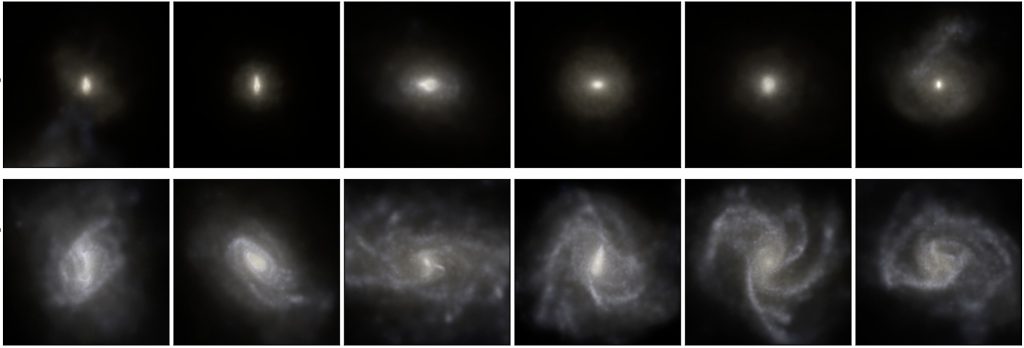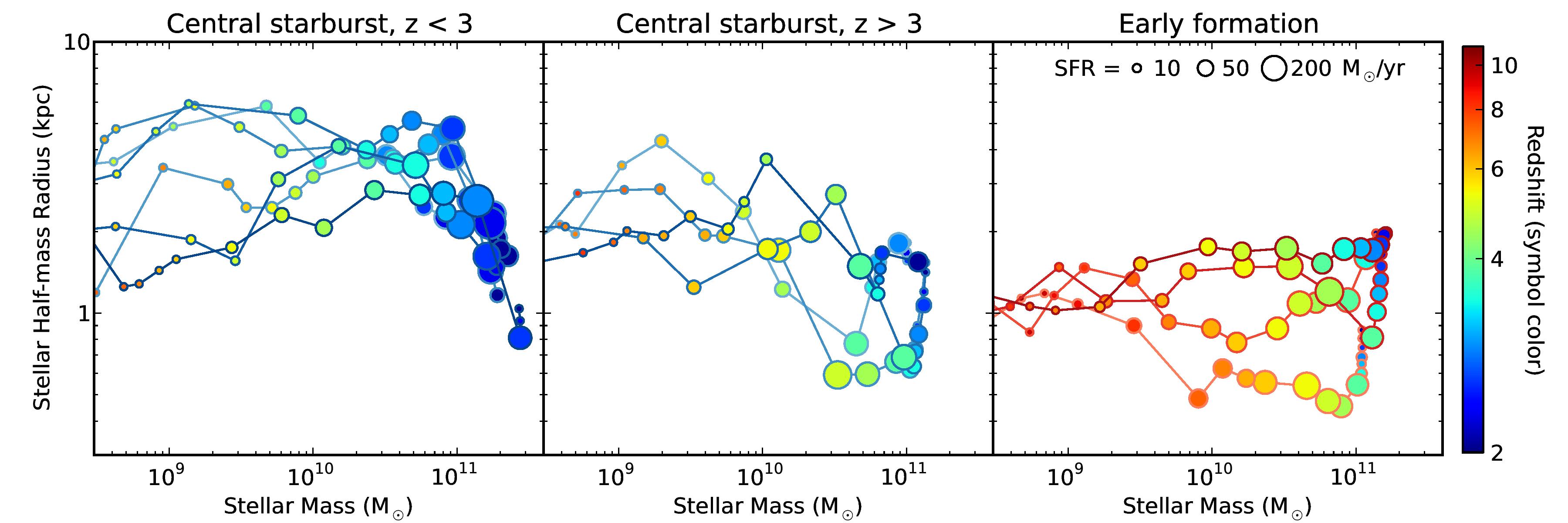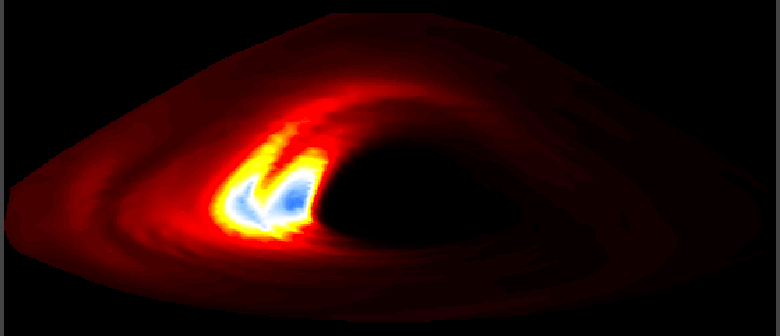Massive compact galaxies (such as those pictured on the top row of the image below) were one of the first surprises astronomers encountered at high redshift (z > 2). These objects have can stellar masses of 10^11 solar masses, but sizes of only 1-2 kpc (considerably smaller than similar-mass galaxies at the present day). They have presented a number of questions for astrophysicists, including: how can such a dense system form, and where are their descendants in the local universe? I have studied these questions by identifying analogs of these compact galaxies in the Illustris simulation, and tracing them back in time to their higher-redshift progenitors and forward in time to their descendants at the present day.

Formation (Wellons et al 2015)
In this paper, I found a sample of 14 massive compact galaxies in Illustris at z=2 and traced them back in time to uncover how they formed. As shown below, I found two mechanisms that produce compact galaxies in the simulation. The first mechanism is simply a very early formation time, as seen on the far right. At very early times, the universe itself is more dense, cold gas is more prevalent, and galaxies naturally form with smaller sizes. Some of the compact galaxies we identify at z=2 are already relics of formation at e.g. z=4. The second mechanism that produces compactness is a centralized and concentrated burst of star formation, as pictured in the left and middle panels. These events occur when cold gas is funneled to the galaxy center through e.g. tidal torques induced by major mergers. Approximately 2/3 of the z=2 compact galaxies in my sample were produced via a central starburst, with the remaining 1/3 owing their compactness to a very early formation time.
Evolution (Wellons et al 2016)
Here I performed the reverse exercise and traced the compact sample forward to discover their present-day descendants. I found a wide variety of evolutionary pathways available to these galaxies, with some gaining an order of magnitude in mass while others maintained a similar stellar mass for 10 Gyr. These galaxies are all quiescent by z=1.5 so their primary source of mass growth is ex-situ through mergers and stripping. There are four general types of descendant among this sample. The most common outcome (pictured in yellow) is for the compact galaxies to undergo a series of mergers with other galaxies which are less tightly-bound, so that they are able to disrupt their merger partners and accrete their stellar contents, building up an ex-situ envelope and existing as the core of a more massive descendant at z=0. This is the evolutionary scenario for approximately half of the z=2 compact sample. The reverse case can also happen, when the compact galaxy is consumed in a merger with a more massive (blue) or similarly-bound (green) galaxy. And finally, about 1/3 of the sample remain more or less undisturbed by mergers and are able to maintain a similar stellar mass. These galaxies are able to avoid merging either by existing in very isolated environments or by falling into very massive clusters, where their high orbital velocities make merging challenging. 
Probabilistic prediction of progenitor properties (Wellons et al 2017)
A commonly-used method to predict the progenitors or descendants of a galaxy population from one redshift to another is the assumption of a constant cumulative comoving number density (i.e., rank order). When this approach has been tested in theoretical works, however, it has been shown to have two weaknesses: (a) There is a systematic shift in the median number density due to galaxy mergers and scatter in growth rates, and (b) the number densities of individual galaxies within a population spread out over time so that the median is a poor descriptor for most of them. In this paper, I present a modified number-density-based method which takes both of these effects into account by predicting the distribution of galaxy rank order within a progenitor/descendant population. By considering distributions rather than a single median value, we can start to address the real complexity and variability in galaxies' evolutionary pathways.

Variability in black hole accretion disks (Wellons et al 2014)
Since black holes don't give off any light of their own, we have to study them indirectly by instead observing their effects on nearby luminous objects. The accretion disks formed by matter falling into black holes are one such indirect probe. In my work with simulated accretion disks, I investigate the variability present in the disk and look for any connection between the properties of the variability (power spectral features) and the properties of the central black hole such as its mass or spin.
One promising feature is produced by the Doppler effect. Observers who are inclined with respect to the disk will see Doppler-boosted emission on the side of the disk with material coming toward them, and dimmed emission on the other side (as in the image to the left). Any fluctuation will thus appear to be boosted and dimmed as it travels around the disk, producing periodicity at the orbital frequency. This Doppler feature is present in the power spectra from our simulated disks, and may be tied to observations of real accreting black holes as well. The location of the Doppler feature is a function of black hole spin (since the inner edge of the accretion disk is a function of spin), so the identification of an observed power spectral feature with this Doppler feature may serve to identify black hole spin.
Thorough observational studies in the local Universe have revealed clear relationships between galaxy mass, size, morphology, and kinematics. In particular, the speed at which a galaxy rotates can be used to infer its mass distribution (and this method provided one of the earliest pieces of evidence for dark matter). At high redshift, however, these familiar relationships can start to look very different!
Measuring dynamical mass from gas kinematics at high redshift (Wellons et al 2020)
I examined the relationship between a galaxy's distribution of mass and its rotational profile in my 2020 paper, utilizing high-resolution zoom-in simulations of massive galaxies (Mstar > 10^11 Msun) to focus on redshifts z > 1 (during the first ~half of the Universe's history). At high redshift, we find that massive galaxies are more compact and that turbulence is elevated in the gaseous disks. This turbulence in galactic disks can provide an additional source of support against gravity and modify the rotational velocity if there are radial gradients in the turbulent pressure. We find that these gradients can significantly affect rotation in the outer disks of these simulated galaxies, and that this effect becomes increasingly important at higher redshift. We examine observational methods for estimating these pressure gradients, and find that dynamical masses can be reasonably well recovered if the turbulent pressure gradients and other physical effects (e.g., the non-spherical geometry of galactic systems) are appropriately accounted for.

